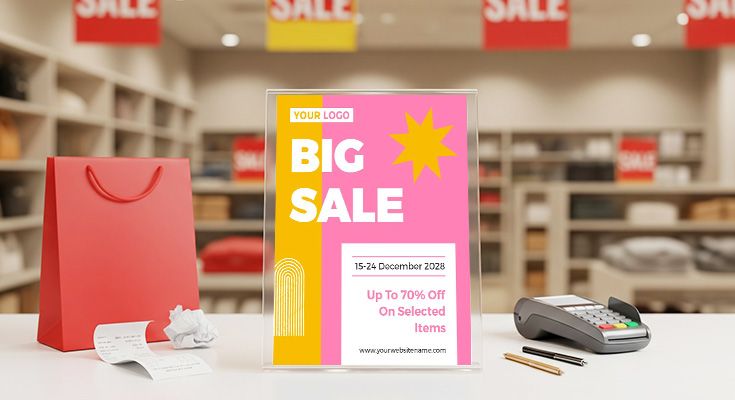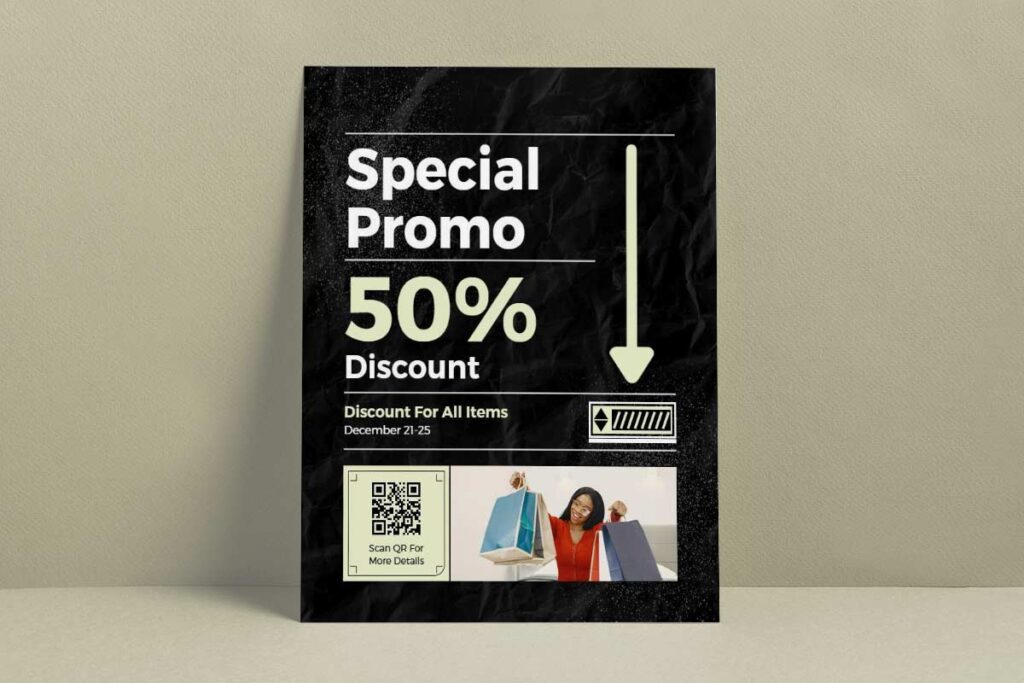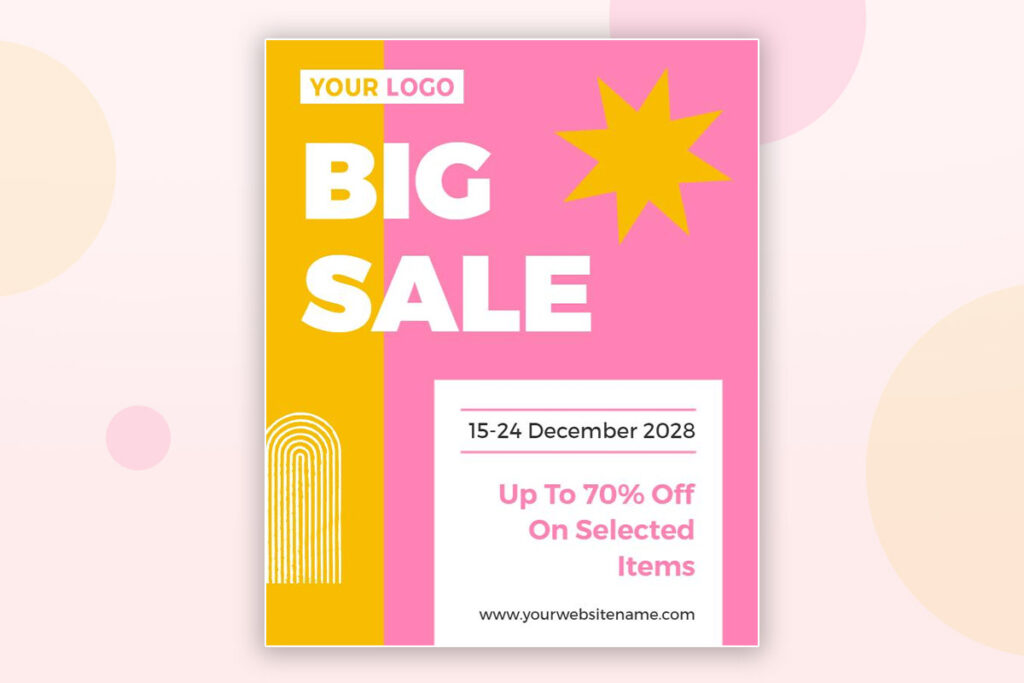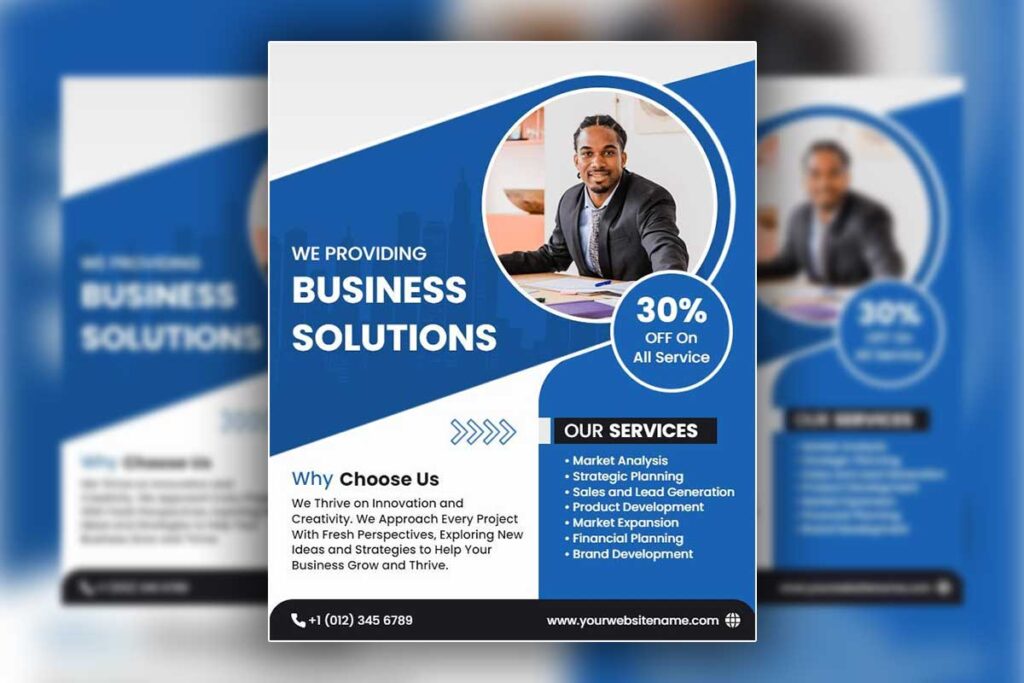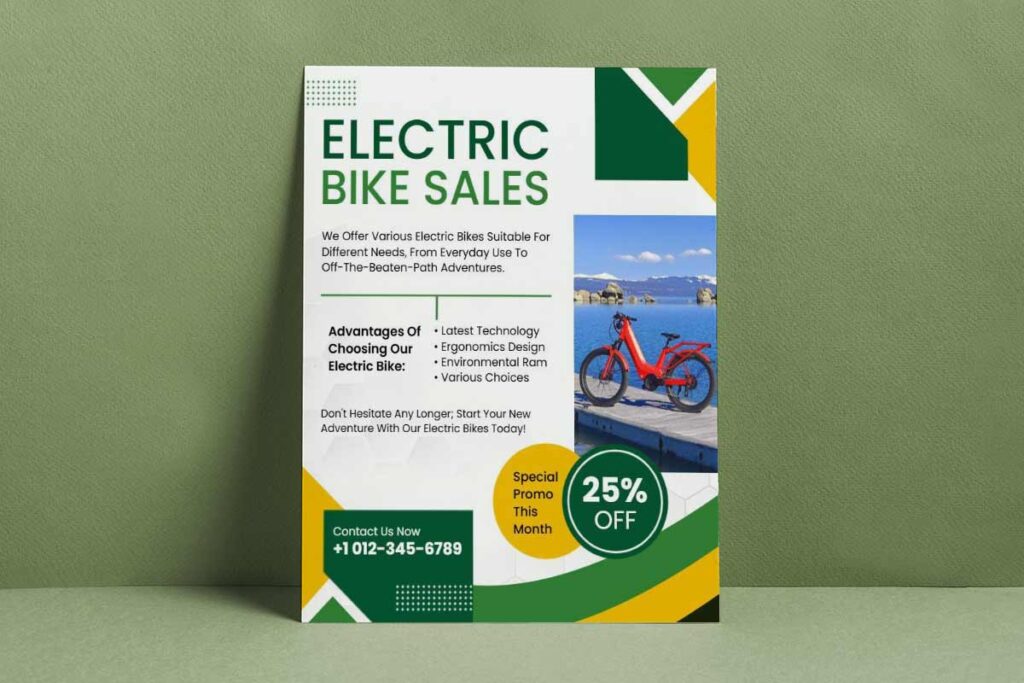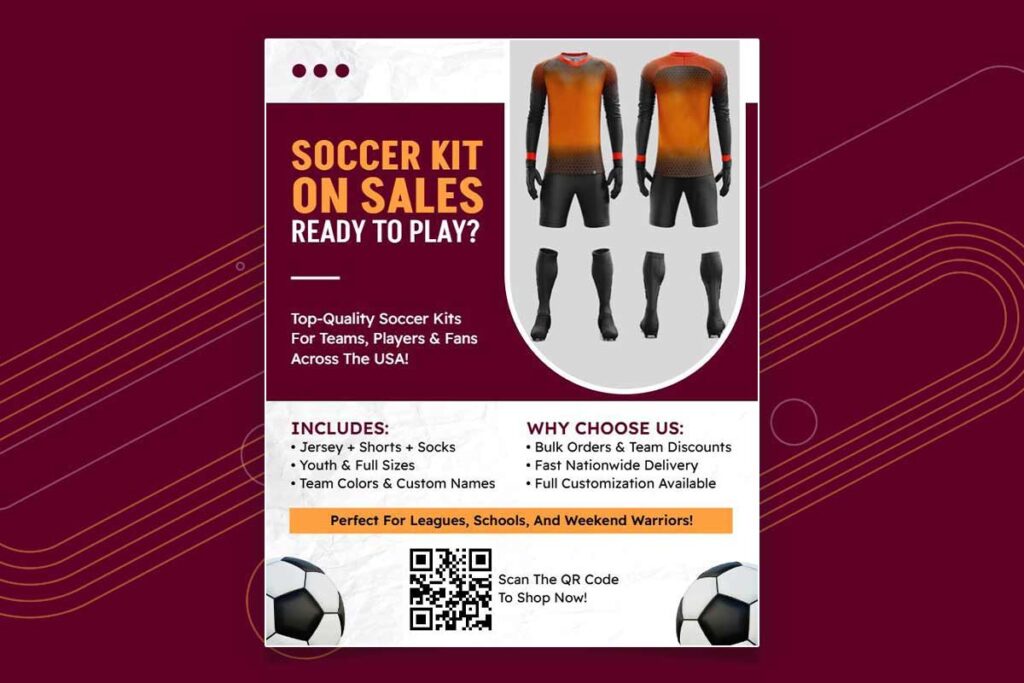Ineffective sales flyers can cause organizations to miss opportunities, as prospects often forget key points without visual support. Strategic sales flyer enhances presentations by reinforcing messaging, maintaining engagement, and driving conversions. Well-crafted big sale promotional flyer Template and sales event flyers serve as lasting takeaways, helping prospects retain benefits and boosting professional credibility. This guide outlines proven design techniques and strategies for effective flyer implementation that maximizes impact and results.
How Can Sales Flyer Design Improve Presentation Conversion Rates For Service Providers?
Strategic sales flyer design enhances presentations by reinforcing key messages and keeping prospects engaged. Well-crafted sales flyers with clear value, visuals, and structured information help prospects retain benefits, while professional sales marketing flyers act as lasting takeaways. Incorporating persuasive elements like testimonials, stats, and strong calls-to-action can boost conversions from presentations to signed contracts. Businesses can create these impactful materials easily using an online flyer maker.
Visual Storytelling Techniques That Transform Verbal Pitches Into Memorable Experiences
Visual storytelling elevates sales flyer design by turning verbal pitches into engaging, memorable experiences (University of Michigan Creative).1 By combining imagery, data, and structured visuals, prospects can better understand and connect with your services.
- Enhancing Verbal Narratives
- Use infographics, client success stories, and before-after comparisons to help prospects visualize outcomes.
- Icons and color-coding guide readers through complex service offerings.
- Professional imagery paired with compelling headlines creates emotional connections.
- Relatable and Industry-Specific Visuals
- Incorporate visual metaphors and industry-specific images to make services personally relatable.
- Charts and data visualizations turn abstract concepts into tangible insights (Harvard Business School Online).2
- Process diagrams clarify service delivery steps.
- Synergy with Spoken Presentations
- Visual elements reinforce verbal pitches, creating multiple touchpoints for comprehension (Baylor University Keller Center for Research).3
- Enhances message retention and helps prospects grasp complex information.
Transform your verbal presentations with professional business flyer templates from DesignWiz, designed specifically for service providers who need compelling visual storytelling elements.
- Modern Orange Small Business Sale Event Flyer Template
- Blue and Yellow Big Sale Flyer Designs Template
Strategic Information Architecture for Guiding Prospect Decision-Making Flow
Information architecture in sales event flyer template directly influences prospect decision-making by controlling attention flow and emphasis placement. Hierarchical layouts using varied font sizes, strategic white space, and bullet point systems guide readers through key benefits in logical sequence. Priority information receives visual prominence through contrasting colors and larger typography.
Decision-making flows improve when flyers present information in consultant-like structures: problem identification, solution overview, implementation process, and expected outcomes. This mirrors natural consultation conversations while providing visual reference points. Service providers benefit from organizing content that addresses common objections preemptively through strategic placement of credibility indicators and risk-mitigation statements.
Effective sales marketing flyer architecture includes clear navigation elements, numbered sections for presenter reference, and highlighted action steps that facilitate next-phase discussions and commitments.
Browse DesignWiz’s collection of sales flyer templates featuring strategic information architecture that guides prospects through your service offerings systematically.
- Corporate Sales Proposal Business Flyer Template
- Corporate Office Land for Sale Flyer Template
- Business Sales Process Presentation Flyer Template
Post-Meeting Reinforcement Through Compelling Takeaway Materials
Well-designed takeaway materials bridge the gap between initial interest and final commitment, extending presentation impact.
- Purpose & Function
- Serve as reference documents to reinforce meeting content.
- Provide prospects with concrete materials for internal discussions and decision validation.
- Include strategically placed contact information for easy re-engagement.
- Content Recommendations
- Implementation timelines, pricing summaries, and next-step clarity to reduce decision friction.
- Client testimonials and case study previews to provide social proof.
- QR codes linking to detailed portfolios or scheduling systems for streamlined follow-up.
- Design & Presentation
- Incorporate subtle urgency through limited-time offers or consultation bonuses.
- Professional binding and high-quality paper convey service value and durability.
- Engagement Strategy
- Materials should be referenced multiple times during the prospect’s decision-making process.
- Phased information disclosure and strategic reminders maintain momentum between presentations and contract signing.
- Sustained visual presence significantly improves overall conversion rates.
What Sales Flyer Design Elements Make Prospects Remember Key Points After Meetings?
Memory-focused sales flyer design uses visual hierarchy, color coding, icons, and infographics to create lasting mental anchors. High-contrast elements, strategic white space, and clear typography help prospects recall key benefits, combat information overload, and leave lasting impressions that influence purchasing decisions.
Cognitive Design Principles That Enhance Information Retention and Recall
Optimizing sales flyer design using cognitive psychology improves memory, comprehension, and brand recognition.
- Color Psychology & Emotional Connections
- Blue builds trust for financial services.
- Green suggests growth for real estate and similar industries.
- Message Structuring
- Apply the rule of three to limit key messages for maximum retention.
- Chunk information into digestible sections to prevent cognitive overload (Rochester Institute of Technology).4
- Use consistent icon placement to guide eye movement naturally.
- Reinforcement & Readability
- Repetition of design elements reinforces critical points without redundancy.
- Maintain contrast ratios above 4.5:1 for readability across age groups.
- Use font hierarchy and size variations to prioritize information naturally.
- Branding & Placement
- Logos and contact information placed consistently enhance brand recognition through repeated exposure.
- Typography & Perception
- Serif fonts suggest tradition and reliability.
- Sans-serif fonts convey modernity and innovation.
- White Space & Layout
- Maintain 40–60% white space to give information breathing room.
- Prevents visual overwhelm, improving message retention rates.
Visual Hierarchy Systems for Highlighting Critical Value Propositions
Effective sales discount promotion flyer Template employ Z-pattern layouts that guide attention through primary headline, supporting imagery, key benefits, and call-to-action sequentially. Size hierarchy places the most important information in larger elements, followed by secondary details in progressively smaller text. Color hierarchy uses brand colors for critical elements while neutral tones support lesser information.
Proximity grouping clusters related information together, creating logical associations between services and benefits. Alignment creates invisible grid systems that provide structure without appearing rigid. Professional sales marketing flyers balance text-to-image ratios at 60:40 for service-focused content, allowing visual elements to support rather than overwhelm written information.
Directional cues like arrows or numbered sequences create logical information flow. Bold formatting highlights key statistics or guarantees, while italics emphasize testimonials or unique value propositions without competing with primary messaging.
Memory Trigger Elements That Keep Your Services Top-of-Mind Long-Term
Incorporating memorable design and content elements ensures prospects recall your services throughout the decision-making process.
- Engagement & Visual Proof
- QR codes linking to video testimonials extend engagement beyond initial contact.
- Before-and-after examples provide powerful, long-lasting visual proof.
- Infographics simplify complex processes into easily digestible visual steps (National Center for Biotechnology Information).5
- Personal Branding & Differentiation
- Professional headshots build trust and recognition.
- Unique visual signatures such as custom graphics, distinctive color combinations, or memorable taglines differentiate your materials.
- Boldly formatted statistics create quotable facts for sharing.
- Comprehensive Contact Integration
- Multiple contact methods: direct calendar links, social media handles, office locations with maps.
- Include emergency contact options to demonstrate availability and commitment.
- Reinforcement & Call-to-Action
- Summary sections at flyer bottoms reinforce key points through repetition without redundancy.
- Limited-time consultations or exclusive offers encourage prompt follow-up while maintaining professionalism.
Which Sales Flyer Design Layouts Work Best For Professional Service Presentations?
Professional service presentations benefit most from clean, structured layouts that prioritize credibility and clarity over flashy design elements. The most effective sale promotional discount offer flyer template approaches feature strategic information hierarchy, ample white space, and layouts that complement rather than compete with verbal presentations. Grid-based systems excel for showcasing multiple service offerings, while single-column formats work best for detailed proposals requiring sequential information flow. Successful layouts maintain consistent branding elements and ensure key contact information remains prominent throughout the design.
Grid-Based Service Portfolio Layouts for Multi-Offering Presentations
Grid layouts organize multiple services into digestible sections that prospects can quickly scan during presentations. This sales flyer design approach uses consistent card-based elements featuring service icons, brief descriptions, and pricing tiers. Each grid section maintains equal visual weight, preventing any single service from overwhelming others.
Effective grid systems incorporate subtle borders or background variations to separate services while maintaining visual cohesion. Sales promotion flyers using this layout typically feature 6-9 service blocks, allowing presenters to discuss each offering systematically. The grid structure guides audience attention naturally from left to right, top to bottom, supporting verbal presentation flow. Professional grid designs include consistent typography hierarchy and strategic color coding to differentiate service categories without creating visual chaos.
- Mid-Year Sale Discount Event Flyer Template
- Fresh Tomatoes Sale Promotional Flyer Template
- Blue and Yellow Big Sale Flyer Designs Template
Single-Column Proposal Formats for Detailed Service Explanations
Single-column layouts excel when presenting complex service packages requiring detailed explanations and sequential information delivery. This sales marketing flyer format mirrors traditional proposal structures, featuring header branding, executive summary sections, detailed service descriptions, and clear pricing presentations.
These layouts accommodate longer text blocks while maintaining readability through strategic typography choices and section breaks. Discount sale event flyer template using single-column formats typically integrate client testimonials, case study highlights, and process timelines that support verbal presentations. The linear structure ensures prospects follow logical information progression from problem identification through service benefits to next steps, making complex offerings more comprehensible during meetings.
White Space Utilization Techniques for Professional Credibility
Proper use of white space enhances flyer readability, professionalism, and prospect trust.
- Purpose & Impact
- Separates professional flyers from cluttered, amateur designs.
- Directs attention to key information without overwhelming prospects.
- Allocates 30–40% of total space to white space for organized, approachable layouts.
- Functional Benefits
- Provides areas for presenter notes or prospect questions during meetings.
- Generous margins and section spacing convey competence and attention to detail.
- Prevents information overload that distracts from verbal presentations.
- Optimal Layout Strategies
- Maintain consistent margins and strategic section breaks.
- Use careful typography spacing to enhance readability.
- Balance information density with visual clarity, ensuring materials support presenter messaging.
How Should Sales Presentation Designers Structure Flyers To Support Verbal Pitches?
Effective sales flyer design aligns presenter and audience through clear information hierarchy and visual cues. Well-structured layouts use numbered points, highlighted stats, and bullet-pointed benefits to guide presentations naturally. Features like color-coded sections, sidebar notes, and prominent contact details help maintain flow, enhance audience focus, and support smooth transitions from pitch to close.
Talking Point Integration Systems for Seamless Presenter Flow
Sales marketing flyers require systematic talking point integration through numbered content blocks corresponding to presentation segments. Effective structures incorporate visual markers like icons or color bands that signal topic transitions, enabling presenters to navigate smoothly between subjects. Strategic placement of key statistics in highlighted boxes provides natural emphasis moments, while bullet-pointed benefit lists create structured discussion frameworks.
Professional designers implement sidebar reference systems containing presenter cues, timing indicators, and additional detail options for audience questions. Content hierarchy follows verbal presentation logic, positioning primary value propositions prominently while supporting details flow in logical sequence. Sales advertisement flyers benefit from strategic white space allocation that prevents information overload during verbal explanations, allowing presenters to elaborate on key points without competing visual distractions.
Visual Anchor Placement Strategies for Audience Retention
Strategically placed visual anchors reinforce verbal messaging and improve audience recall.
- Optimal Placement
- Position compelling visuals at natural eye-rest points: upper-left quadrants and center-bottom sections.
- Align visuals with presentation flow to guide audience attention.
- Contrast & Visual Hierarchy
- Use color blocking and contrast principles to highlight critical information.
- Employ size variation, typography weight, and spacing patterns to direct focus.
- Icons and infographics act as memory triggers, ensuring lasting impressions.
- Brand Consistency & Credibility
- Incorporate consistent branding elements to reinforce company recognition.
- Strategically place testimonials, case study highlights, and success metrics for credibility without overwhelming the core message.
- Audience Retention Focus
- Visual anchors help information survive post-meeting decay.
- Support verbal messaging while keeping presentation flow smooth.
Follow-Up Action Sections That Drive Post-Presentation Engagement
Well-designed action sections guide prospects toward next steps and maximize post-presentation engagement.
- Strategic Placement & Call-to-Action
- Position prominent call-to-action blocks in natural conclusion areas.
- Use action-oriented language and visual prominence to encourage immediate response.
- Multiple Engagement Options
- Include consultation scheduling, resource downloads, and varied contact preferences.
- Accommodate different decision-making styles of prospects.
- Urgency & Incentives
- Incorporate limited-time offers or exclusive consultation opportunities.
- Encourage prompt engagement without appearing pushy.
- Digital Integration & Contact Info
- Use QR codes for instant digital engagement.
- Provide multiple communication channels and clear value propositions.
- Supporting Materials & Structure
- Include meeting recap sections for reference of key discussion points.
- Add proposal timelines and additional resources to extend engagement.
- Place action sections at the flyer bottom to align with presentation conclusion while maintaining visual accessibility.
Maximize post-presentation engagement with DesignWiz’s action-focused flyer templates that include proven call-to-action sections and follow-up elements.
- Final Sale Discount Promotion Flyer Template
- Big Retail Sale Promotional Flyer Template
- Crazy Sale Event Promotional Flyer Template
What Sales Flyer Design Mistakes Reduce Meeting Follow-up Conversion Rates?
Critical sales flyer design mistakes, like cluttered layouts, poor visual hierarchy, weak branding, low-quality images, missing calls-to-action, and inconsistent messaging, can drastically reduce conversion rates. Without strong visual support, service providers lose 40–60% more prospects. Effective flyer design bridges presentations and signed contracts, making attention to design essential for maximizing conversions.
Cluttered Information Architecture That Overwhelms Decision-Makers
Dense text blocks and competing visual elements create cognitive overload that prevents prospects from identifying key benefits after meetings end. Sales promotion flyers crammed with multiple fonts, excessive bullet points, and scattered information force decision-makers to work harder to extract value, leading to abandonment.
Professional sales marketing flyers require strategic white space allocation and logical information flow that guides readers through service benefits systematically. Successful designs limit primary messages to three core value propositions with supporting details organized in digestible sections. Clear section breaks and consistent spacing prevent information overwhelm while maintaining comprehensive coverage.
Weak Visual Branding That Fails to Reinforce Sales Presentations
Inconsistent visual identity between verbal presentations and supporting materials creates disconnected experiences that reduce memorability and professional credibility. Generic sales advertisement flyers using stock templates without customization fail to differentiate service providers from competitors, making follow-up decision-making more difficult.
Brand reinforcement through consistent color schemes, professional typography, and recognizable design elements helps prospects recall specific presentations weeks later. Sales event flyer design must align with existing marketing materials and verbal messaging to create cohesive professional impressions that support conversion momentum.
Missing Strategic Call-to-Action Placement for Post-Meeting Engagement
Absent or poorly positioned calls-to-action leave prospects uncertain about next steps, causing conversion opportunities to stagnate between initial meetings and final decisions. Effective sales flyer design includes multiple strategic touch points that guide prospects toward specific follow-up actions without appearing pushy or sales-focused.
Successful follow-up conversion requires clear contact information placement, specific next-step instructions, and urgency elements that encourage timely responses. Position primary contact details prominently in multiple locations while including secondary actions like scheduling follow-up meetings or accessing additional resources. Mobile-optimized contact integration ensures prospects can engage immediately when reviewing materials on smartphones.
The most effective sales flyers include time-sensitive elements that create appropriate urgency without pressure, such as limited consultation availability or seasonal service benefits that align with prospect business cycles.
Which Sales Flyer Design Tools Help Presentation Designers Create Supporting Materials Quickly?
Professional presentation designers rely on Adobe Creative Suite (InDesign, Illustrator) for comprehensive sales flyer design, offering advanced typography and brand consistency controls. DesignWiz provides editable flyer templates with sales-specific layouts, while Figma excels at collaborative design workflows for client feedback integration. Specialized tools like Lucidpress streamline brand-compliant sales advertisement flyer production, and newer AI-powered platforms like Gamma and Beautiful.AI accelerate initial concept development. These tools enable designers to efficiently produce cohesive sales event flyer designs that seamlessly complement verbal presentations and maintain professional visual standards across all client touchpoints.
Professional Design Software vs. Template-Based Platforms for Sales Materials
Choosing the right design platform is essential for creating effective sales materials. Professional software offers full customization for complex projects, while template-based platforms streamline creation for faster, consistent results.
- Template-Based Platforms (e.g., DesignWiz)
- Pre-designed sales promotion flyer layouts reduce creation time from hours to minutes.
- Drag-and-drop interface simplifies design for non-experts.
- Features industry-specific templates, brand kit integration, and collaboration tools.
- Ideal for quick client turnarounds and standardized marketing materials.
- Professional Design Software (e.g., Adobe Creative Suite)
- InDesign: Advanced layout controls for precise flyer creation.
- Illustrator: Vector graphics capabilities for custom designs.
- Offers unlimited customization, ideal for complex projects.
- Requires significant design expertise and time investment.
- Decision Factors
- Use template platforms for faster execution with less technical skill required.
- Use professional software for complex, highly customized projects.
- Choice depends on project complexity, timeline, and customization needs.
Streamline your design process with DesignWiz’s extensive collection of sales flyer templates, offering industry-specific layouts and customizable elements for rapid deployment.
- Special Discount Promotion Sale Flyer Template
- Vibrant Red End of Season Sale Discount Flyer Template
- Big Sale Promotional Discount Offer Flyer Template
Collaborative Design Tools That Streamline Client Feedback Integration
Modern design platforms enable efficient collaboration, reducing revision cycles and improving communication.
- DesignWiz
- Approval workflows maintain brand consistency.
- Multiple stakeholders can edit simultaneously.
- Lucidpress
- Brand-controlled collaboration prevents unauthorized design changes.
- Enables team input while protecting brand guidelines.
- Figma
- Real-time editing with integrated comment systems.
- Clients provide feedback directly on specific design elements.
- Automatic version history tracks all changes.
- InVision
- Presentation-focused feedback tools for interacting with flyer prototypes.
- Facilitates client review before final production.
- Overall Benefits
- Centralizes feedback and communication.
- Reduces revision cycles from weeks to days.
- Ensures clear collaboration throughout the design process.
AI-Enhanced Design Platforms for Rapid Sales Promotion Flyer Development
AI-powered platforms accelerate flyer creation, ensuring cohesive and professional marketing materials.
- DesignWiz’s AI Flyer Generator offers smart templates, automated layout suggestions, and brand-consistent designs, reducing creation time by 60–80%.
- Gamma and Beautiful.AI streamline design workflows, making flyer development faster and more efficient.
- Tome and Presentations.AI focus on presentation-based flyer designs for visually engaging marketing materials.
- Adobe Creative Suite’s AI features, including generative fill and smart cropping, support designers in optimizing layouts.
AI assistance is most valuable for initial concept generation and layout optimization, while human oversight ensures professional quality for client-facing materials.
How Can Sales Flyer Design Templates Streamline Service Provider Presentation Prep?
Sales flyer templates save time by providing customizable, pre-structured layouts with consistent branding, professional typography, and clear information hierarchy. They reduce design stress, ensure visual consistency across meetings, and let service providers focus on compelling content, improving presentation quality and confidence.
Pre-Built Layout Systems That Reduce Design Decision Fatigue
Template-based sales flyer design eliminates overwhelming layout decisions by providing tested visual hierarchies and proven content placement patterns. Service providers avoid paralysis from endless design possibilities, instead selecting from curated layouts optimized for prospect engagement. These pre-built systems include strategic headline placement, service benefit sections, testimonial areas, and contact information positioning that converts prospects effectively.
Professional templates incorporate visual balance principles, ensuring key messages receive appropriate emphasis without overwhelming readers. Color schemes, typography pairings, and spacing ratios are pre-calculated to maintain readability and professional credibility. Service providers simply insert their content into proven frameworks rather than experimenting with untested layouts during critical preparation periods.
Sales event flyer designs within template libraries offer industry-specific variations, allowing providers to match their service presentation style while maintaining conversion-optimized structure throughout their marketing materials.
Standardized Brand Elements for Consistent Professional Image
Template systems maintain brand consistency across all client presentations through standardized color palettes, typography selections, and logo placement protocols. Service providers build recognition and trust by delivering cohesive visual experiences that reinforce their professional image with every prospect interaction. Consistent branding elements prevent the scattered appearance that undermines credibility during competitive sales processes.
Sales marketing flyer templates include predetermined brand zones for company information, ensuring contact details and credentials appear prominently without disrupting design flow. Professional typography hierarchies guide reader attention from headlines through service descriptions to action steps, creating predictable information consumption patterns that improve comprehension rates.
Standardized elements reduce quality control concerns, as service providers know each presentation maintains professional standards regardless of individual design skills. This consistency extends credibility beyond single meetings, building cumulative brand recognition across prospect touchpoints and referral networks within target markets.
Time-Saving Customization Workflows for Multiple Client Presentations
Template-driven workflows allow service providers to efficiently create multiple client presentations while maintaining professional quality and visual consistency.
- Template systems use master layouts that accommodate various service packages, allowing adjustments without full redesigns.
- Content libraries contain pre-written service descriptions, benefit statements, and testimonials for rapid personalization.
- Sales flyer templates support quick client logo integration, personalized headlines, and custom contact information without affecting overall design integrity.
- Variable template sections enable basic, standard, and premium service displays through simple content swaps.
- Batch processing allows multiple presentations to be updated simultaneously, saving significant preparation time.
- Digital template workflows integrate with presentation software, ensuring smooth delivery while preserving formatting and professional appearance.
Accelerate client presentation preparation with DesignWiz’s customizable business sale flyer templates designed for quick personalization across multiple client projects.
- Lavender Pinocchio Cyber Monday Flyer Template
- Final Sale Fifty Percent Discount Flyer Template
- Exclusive Online Shopping Sale Flyer Template
What Sales Flyer Design Principles Maximize Client Retention After Initial Meetings?
Effective sales marketing flyer design boosts client retention by creating memorable visual anchors. Using strategic white space, consistent colors, clear value hierarchy, and prominent contact info helps prospects easily absorb key benefits. Visual storytelling and professional typography reinforce credibility, keeping engagement strong between meetings.
Memory-Triggering Visual Elements That Reinforce Key Messages
Sale discount promotional flyer template optimization focuses on creating visual anchors that persist in prospect memory through strategic icon usage, infographic elements, and color-coded information sections. Effective memory triggers include consistent brand colors that create psychological associations, memorable imagery that connects to service benefits, and visual metaphors that simplify complex concepts.
Professional designers utilize contrast ratios of 4:1 minimum for text readability and implement visual hierarchy through size variations that guide attention naturally. Strategic placement of client testimonials with headshots creates human connections, while before-and-after comparisons demonstrate tangible results prospects can visualize. These elements work synergistically to combat information overload and create lasting impressions that influence purchasing decisions weeks after initial presentations conclude.
Strategic Contact Integration for Seamless Follow-Up Communication
Contact information positioning determines follow-up success rates, requiring prominent placement in both header and footer sections with multiple communication channels clearly displayed. Sales promotion flyer designs should include QR codes linking to calendar booking systems, enabling instant meeting scheduling while prospect interest remains high. Professional formatting includes phone numbers with click-to-call functionality, email addresses formatted for easy copying, and physical addresses when location relevance applies.
Strategic contact placement appears every 300-400 words throughout longer flyers, ensuring prospects never lose connection points during extended reading sessions. Additional elements include social media handles for modern engagement preferences and specific contact persons assigned to different services, personalizing the follow-up experience and reducing prospect confusion.
Value Proposition Hierarchy That Drives Post-Meeting Decision Making
Value proposition architecture begins with primary benefit statements positioned prominently in the upper third of flyers, followed by supporting benefits organized through numbered lists or bullet hierarchies. Sales event flyer design utilizes headline sizes decreasing incrementally from H1 primary value (24-28pt) to H2 supporting benefits (18-20pt) to H3 feature details (14-16pt). Strategic white space allocation provides breathing room between value sections, preventing cognitive overload while maintaining visual flow.
Compelling statistics appear in highlighted callout boxes with contrasting backgrounds, creating immediate attention focal points. Service packages receive equal visual weight through consistent formatting, while premium offerings gain subtle emphasis through enhanced visual treatment without appearing pushy. Call-to-action placement occurs after each major value section, providing natural decision points throughout the prospect’s reading journey. This systematic approach ensures prospects can quickly locate relevant information during post-meeting review periods when making final purchasing decisions.
How Does Professional Sales Flyer Design Compare To Verbal-only Presentations For Conversions?
Professional sales flyer design outperforms verbal-only presentations by creating visual anchors that boost retention and credibility. Engaging multiple senses with clear hierarchy, compelling headlines, and color strategy, flyers increase comprehension and serve as lasting takeaways, extending the sales conversation and driving higher conversion rates.
Retention Rate Analysis: Why Visual Sales Materials Outperform Spoken Words
Sales flyer design creates memory anchors that verbal presentations cannot match. Visual hierarchy guides attention to key benefits while color coding helps prospects categorize information effectively. Strategic white space prevents cognitive overload that often occurs during lengthy verbal pitches.
Effective sales advertisement flyers use bullet points, infographics, and highlighted statistics to reinforce verbal messages. Prospects can reference specific details weeks later, while verbal-only information typically fades within 72 hours. Professional typography choices and consistent branding patterns enhance recall rates by creating visual familiarity.
Credibility Enhancement Through Professional Sales Advertisement Flyer Design
Visual marketing materials establish immediate credibility through polished design aesthetics and organized information presentation. Clean layouts suggest organizational competence, while high-quality imagery reinforces professional standards. Sales event flyer designs with client testimonials and case studies provide social proof that verbal claims cannot match.
Typography consistency and brand alignment demonstrate attention to detail that prospects associate with service quality. Professional sales marketing flyers reduce skepticism by providing tangible evidence of capabilities. Visual elements like charts, graphs, and portfolio previews offer concrete proof points that verbal descriptions struggle to convey effectively.
Post-Meeting Impact: How Flyers Extend Your Sales Conversation
Sales promotion flyers continue selling after presentations end, maintaining engagement during decision-making periods. Prospects reference materials when discussing services with colleagues or stakeholders, extending your influence beyond initial meetings. Well-designed takeaways keep your services top-of-mind while competitors fade from memory.
Strategic contact information placement ensures easy follow-up communication. QR codes enable instant digital connections, while clear value propositions remind prospects of key benefits during evaluation periods. Professional sales advertisement flyers serve as decision-making tools that prospects can review multiple times. Understanding how to maximize business sales sales with flyers can significantly improve your overall conversion rates throughout the sales cycle.
Effective flyers include next-step guidance and urgency elements that prompt action. Visual reminders of limited-time offers or consultation availability create motivation for faster decision-making. Unlike verbal presentations that end when meetings conclude, professional flyers maintain persuasive influence throughout extended sales cycles, driving significantly higher conversion rates through sustained engagement and professional credibility reinforcement.
Which Sales Flyer Design Formats Work Best For B2B Service Provider Meetings?
B2B meetings require sales flyer designs that convey credibility and professionalism. Tri-folds, single-page summaries, portfolio flyers, and infographics each serve specific purposes, while digital flyers with QR codes support seamless follow-ups. Clean layouts, professional typography, strategic white space, and strong calls-to-action drive prospects toward next steps.
Executive Summary Flyers: Capturing C-Suite Attention in B2B Sales Meetings
C-suite executives require information presented with maximum efficiency and minimal visual clutter. Single-page executive summary flyers deliver key service benefits within 30 seconds of scanning time. Effective sales promotion flyers feature prominent value propositions in the top third, supporting statistics in the middle section, and clear next-step actions at the bottom.
Design elements include bold headlines stating specific ROI percentages, bullet-pointed capability summaries, and professional headshots that build personal trust. Sales marketing flyers targeting executives avoid detailed process explanations, instead focusing on business outcomes and competitive advantages. White space usage prevents information overload while maintaining premium appearance standards.
Typography hierarchy guides attention from primary benefits to secondary details, ensuring busy executives absorb critical information even during brief reviews. Contact information remains prominent but unobtrusive, supporting immediate follow-up without overwhelming the core message.
Portfolio Format Excellence: Showcasing Service Provider Credibility Through Design
Portfolio-style sales advertisement flyers transform service descriptions into visual proof of capability and results. Multi-panel formats allow comprehensive case study presentations while maintaining professional organization. Each panel focuses on specific service areas with before-and-after examples, client testimonials, and quantifiable outcomes.
Strategic image placement showcases actual work samples rather than generic stock photography, building authentic credibility with B2B prospects. Sales event flyer designs incorporate client logos, project timelines, and measurable results that resonate with business decision-makers seeking proven track records.
Grid-based layouts organize multiple service offerings without creating visual chaos, while consistent branding elements maintain professional cohesion across panels. Color coding differentiates service categories while preserving overall design unity. Portfolio formats work exceptionally well for consulting, marketing, and professional service presentations where demonstrating expertise through examples builds stronger conversion potential than verbal descriptions alone.
Showcase your expertise with DesignWiz’s professional sales flyer templates that highlight credibility and proven results for service-based businesses.
- Super Sale Discount Event Flyer Template
- January Sale Promotional Flyer Template
- Super Sale Discount Promotion Flyer Template
Digital Integration Strategies: QR Codes and Interactive Elements for Modern B2B Sales
Integrating digital features into physical flyers enhances engagement, tracking, and prospect experience.
- Strategic QR Code Placement
- Enables instant access to case studies, pricing, and booking calendars without disrupting meetings.
- Interactive Elements
- Calendar booking links for immediate follow-up scheduling.
- Video testimonials accessible through mobile scanning.
- Downloadable resources that extend value beyond initial meetings.
- Mobile-Optimized Landing Pages
- Ensure consistent branding and messaging across channels.
- Provide expanded portfolio samples, service descriptions, and pricing calculators.
- Analytics & Engagement Tracking
- Measure prospect engagement levels and content preferences.
- Heat mapping identifies which service offerings generate the most interest.
- Hybrid Digital-Physical Approach
- Combines traditional credibility of physical flyers with modern digital convenience.
- Maximizes conversion opportunities across diverse prospect communication preferences.
People Also Ask: Create Effective Flyer Designs And Materials Implementation Questions
- What makes a sales flyer design effective for presentations?
Clear visual hierarchy, compelling headlines, benefit-focused content, professional imagery, and strong calls-to-action. Include client testimonials, service overviews, and contact information while maintaining consistent branding throughout. - How much should sales flyer design cost for presentation materials?
Professional design ranges $200-800 per flyer, DIY tools cost $10-30 monthly, templates start at $5-50 each. Factor in printing costs of $0.50-2.00 per flyer depending on quality and quantity. - Which sales flyer design software works best for beginners?
DesignWiz offers intuitive templates, Adobe Express provides professional tools, Figma enables collaboration. All include presentation-specific templates, brand consistency features, and print-ready export options for service providers. - How long does professional sales flyer design take to complete?
Simple flyers require 2-4 hours, complex designs need 8-15 hours. Template customization takes 1-2 hours. Factor in revision rounds, content gathering, and printing preparation time for project planning. - What size should sales flyers be for presentation handouts?
Standard 8.5×11 inches fits portfolios and folders easily. A4 size works internationally. Tri-fold brochures maximize information while remaining portable. Choose based on content volume and distribution method. - Can sales flyer design improve presentation conversion rates?
Yes, visual support materials increase retention by 65% and conversion rates by 30-40%. Flyers provide reference points for prospects and reinforce verbal presentations with tangible takeaways.
Frequently Asked Questions
- How can sales presentation designers integrate flyer materials into client meetings effectively?
Distribute flyers at key points, use visuals to reinforce talking points, guide discussion flow, and leave branded materials for later reference. - What budget-friendly sales flyer design options work for independent presentation designers?
Use DesignWiz, Adobe Express, or Figma ($10–15/month). Focus on reusable templates, stock photos, and print-ready formats. - How do successful sales flyer designs complement verbal presentation techniques?
Highlight 3–5 key benefits visually, include bullet points, testimonials, and clear contact info to support your spoken narrative. - Which sales flyer design elements increase follow-up meeting bookings for service providers?
Include QR codes for instant bookings, clear CTAs, limited-time offers, case study previews, and professional visuals to build trust. - How should presentation designers measure sales flyer effectiveness in client meetings?
Track conversions, follow-up requests, and client feedback. Use unique QR codes or landing pages for digital engagement comparisons. - What sales flyer design formats work best for different types of service presentations?
Consulting: detailed case studies. Creative: portfolio previews. Technical: before/after and ROI visuals. Match complexity to service type. - How can sales presentation designers create flyer templates for recurring client types?
Use modular templates with interchangeable sections, customizable logos, testimonials, and pricing tiers while keeping brand consistency. - Which printing specifications ensure professional sales flyer quality for client meetings?
100–120gsm paper, CMYK full-color, matte/satin finish, 8.5×11/A4, 300 DPI, and bleed margins for edge-to-edge printing. - How do digital vs print sales flyers impact presentation designer success rates?
Print provides tangible takeaways, boosting recall. Digital enables instant sharing and analytics. Use both strategically. - What legal considerations should presentation designers include in sales flyer content?
Include disclaimers, trademarks, privacy statements, testimonial permissions, and accurate contact/licensing info. Comply with industry rules.
Conclusion: Create Effective Flyer Designs And Materials Success Framework
Effective sales flyers enhance presentation outcomes by turning verbal messaging into memorable visual experiences. By combining professional design principles, clear visual hierarchy, and conversion-focused content, these flyers reinforce key points, maintain prospect engagement, and serve as tangible reference materials that extend the impact of meetings.
Long-term success comes from integrating template-driven layouts, portfolio showcases, and digital follow-up tools like QR codes to streamline workflows and support ongoing client interactions. When executed strategically, sales flyers improve information retention, reduce follow-up effort, and transform single presentations into sustained business growth opportunities.
Reference
- Harnessing the Power of Visual Storytelling – University of Michigan Creative.
- Data Storytelling: How to Tell a Story with Data – Harvard Business School Online.
- INSIDER: The Power of Visual Storytelling – Baylor University Keller Center for Research.
- Cognitive Load, Memory, and Instruction – Rochester Institute of Technology.
- Designing Infographics: Visual Representations for Enhancing Education, Communication, and Scientific Research – National Center for Biotechnology Information.
